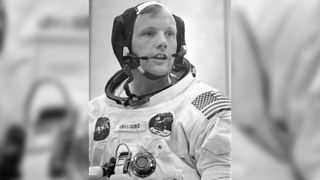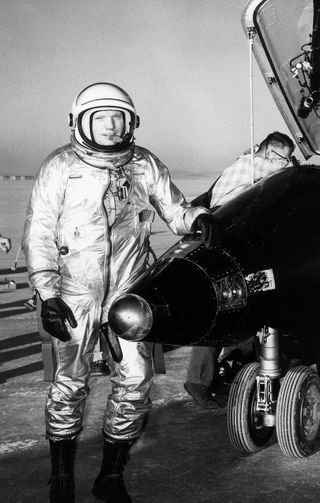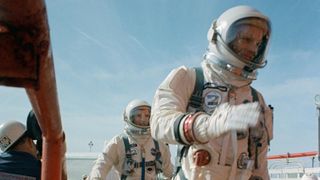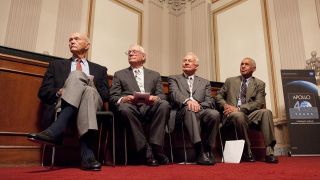Neil Armstrong: First man on the moon
A brief biography of Neil Armstrong.

Neil Armstrong was a NASA astronaut and aeronautical engineer. He famously became the first person to walk on the moon on July 20, 1969 during Apollo 11. Armstrong also flew on NASA's Gemini 8 mission in 1966.
He retired from NASA in 1971 and remained active in the aerospace community, although he chose to keep mostly out of the public spotlight. Armstrong died Aug. 25, 2012, at age 82.
Armstrong was famously reticent about his accomplishments, preferring to focus on the team that helped him get to the moon rather than his own first steps. "I guess we all like to be recognized not for one piece of fireworks, but for the ledger of our daily work," Armstrong said in an interview with CBS's "60 Minutes" program in 2005.
In another interview, when asked what it feels like to have his footprints remain on the moon's surface for thousands of years, Armstrong said, "I kind of hope that somebody goes up there one of these days and cleans them up," The Independent reported.
Early career and NASA work
Armstrong was born in Wapakoneta, Ohio, on Aug. 5, 1930, to Stephen Koenig Armstrong and Viola Louise Engel.
Neil was a naval aviator from 1949 to 1952 and served in the Korean War. He earned his bachelor of science degree in aeronautical engineering from Purdue University in 1955. (Many years later, after he became world-famous, he also received a master of science in aerospace engineering from the University of Southern California in 1970.)
Armstrong became a test pilot for NASA (then known as NACA, the National Advisory Committee for Aeronautics) and flew the X-15, a rocket-powered, missile-shaped aircraft that tested the limits of high-altitude flight. During his long career as a pilot, Armstrong flew more than 200 different aircraft, from jets to gliders and even helicopters.

In 1962, Armstrong was selected to be part of NASA's second group of astronauts, who flew on the two-seat Gemini missions to test out space technology, and the three-seat Apollo missions that ultimately took 12 people to the surface of the moon. Armstrong's first flight was as command pilot of the Gemini 8 mission in March 1966 — the sixth crewed mission of that series.
Armstrong and pilot David Scott completed the first orbital docking of two spacecraft, joining their Gemini 8 spacecraft to an uncrewed Agena target vehicle. However, the two-man crew experienced a serious problem when a thruster on the Gemini 8 spacecraft became stuck open. With the astronauts whipping around faster than one revolution per second, Armstrong managed to gain control again by using the re-entry system thrusters. The event was the first serious emergency in space and although the mission ultimately ended safely, the spacecraft was forced to splash down early because the re-entry system was already expended.
Armstrong also narrowly avoided a nasty accident in May 1968, this time within Earth's atmosphere, while flying the Lunar Landing Research Vehicle — a machine that could fly somewhat like a lunar module and simulate landings on the moon. Fuel for the attitude thrusters ran out and Armstrong was forced to eject just seconds before the vehicle crashed, NASA reported. Armstrong escaped unharmed.

Apollo 11 and the first moonwalk
The Apollo 11 crew members were announced to the public in January 1969. NASA's chief of the Astronaut Office, Donald Kent "Deke" Slayton, chose an all-veteran team of Neil Armstrong (Gemini 8), Edwin "Buzz" Aldrin (Gemini 12) and Michael Collins (Gemini 10), with Armstrong selected to command the mission. His responsibilities included landing on the moon alongside Aldrin, the pilot of the lunar module Eagle. Collins would remain in lunar orbit aboard the command module Columbia. (Collins was originally supposed to be backup pilot for Apollo 11, but his spot in the flight sequence was moved after required surgery on his back forced him off the prime crew for Apollo 8.)
As the lander approached the moon, Armstrong took over the controls when he saw that the computer was guiding them to a boulder-filled landing zone. At 4:14 p.m. EDT (2014 GMT), Armstrong and Aldrin landed on the moon, with only 25 seconds of fuel left. Armstrong radioed, "Houston, Tranquility Base here. The Eagle has landed." Capsule communicator and astronaut Charles Duke responded from Earth: "Roger … Tranquility, we copy you on the ground. You got a bunch of guys about to turn blue. We're breathing again. Thanks a lot."
The schedule called for the astronauts to sleep before the first moonwalk, but they elected to go outside early because they felt they would not be able to sleep. In view of a black-and-white television camera transmitting his movements live to Earth, Armstrong descended Eagle's lander and touched his left foot upon the surface at 10:56 p.m. EDT July 20 (0256 GMT July 21). His first words were "That's one small step for a man, one giant leap for mankind." (The "a" was lost to radio static, but later analysis of the sound wave showed that Armstrong did say it.)
Armstrong and Aldrin together explored the surface during a moonwalk that lasted 2 hours and 36 minutes. They collected 48.5 pounds (22 kilograms) of material from the surface — including 50 moon rocks — as well as deploying experiments, planting the U.S. flag and taking a moment to speak with the U.S. president at the time, Richard Nixon.
The Eagle's crew lifted off safely from the moon on July 21, docked with Columbia, and voyaged back to Earth for a successful ocean landing on July 24. The astronauts went into quarantine to mitigate the (unlikely) risk that they were carrying some sort of moon germs back with them, and then embarked on a world tour to celebrate the mission.
After Apollo 11, and Armstrong's death
After his time as an astronaut, Armstrong was deputy associate administrator for aeronautics at NASA headquarters. He resigned from NASA in 1971. From 1971 to 1979, he was a professor of aerospace engineering at the University of Cincinnati. Then from 1982 to 1992, Armstrong was chairman of Computing Technologies for Aviation Inc. in Charlottesville, Virginia. Armstrong also participated in the Rogers Commission, which was a presidential commission tasked to look at the causes and events of the fatal Challenger shuttle explosion of Jan. 28, 1986, that killed seven astronauts.
Armstrong chose to mostly stay out of the spotlight after leaving NASA, although he did reappear periodically for interviews or for anniversary events concerning Apollo 11. Although his public statements were few, he followed spaceflight news and occasionally made public comments on what was happening. He remained a vocal supporter of suborbital spaceflight. On the other hand, the former Apollo astronaut was publicly critical of plans to shift crewed spaceflight from NASA to private spacecraft.
On Aug. 7, 2012 — two days after Armstrong turned 82 years old — the famed moonwalker underwent coronary bypass surgery. Complications from the surgery resulted in his death on Aug. 25.
"Neil was our loving husband, father, grandfather, brother and friend," his family wrote on the website neilarmstronginfo.com. "For those who may ask what they can do to honor Neil, we have a simple request," they added. "Honor his example of service, accomplishment and modesty, and the next time you walk outside on a clear night and see the moon smiling down at you, think of Neil Armstrong and give him a wink."
Tributes poured in from many public figures, including President Barack Obama, Republican presidential candidate Mitt Romney, then-NASA administrator Charles Bolden, Apollo 11 crewmates Aldrin and Collins, and various space representatives in the public, private and nonprofit spheres.
"Neil was among the greatest of American heroes — not just of his time, but of all time," Obama's statement read. "When he and his fellow crew members lifted off aboard Apollo 11 in 1969, they carried with them the aspirations of an entire nation. They set out to show the world that the American spirit can see beyond what seems unimaginable — that with enough drive and ingenuity, anything is possible."
A private memorial service for Armstrong was held Aug. 31, 2012, at the Camargo Club in Cincinnati. Two weeks later, a publicly televised memorial service was held at the National Cathedral in Washington, D.C.
Armstrong was buried at sea Sept. 14, 2012, in a ceremony aboard the guided missile cruiser USS Philippine Sea. Armstrong's family was on board when the ship left port in Mayport, Florida, and they released his ashes somewhere in the Atlantic Ocean. Obama ordered flags around the United States to fly at half-staff on the day of the funeral.
Armstrong's legacy
In 2015, the Smithsonian Institution revealed that Armstrong had kept aside a cloth bag full of small parts from the lunar module Eagle, which lay undiscovered for decades until his widow, Carol, found it. While Armstrong made no mention of this bag in decades of interviews, the bag was discussed a few times during the mission.
It is unknown how Armstrong ultimately gained possession of the bag, but it was common during the Apollo years for astronauts to retain souvenirs of their flights. (A month after Armstrong's death, Obama made legal a bill to allow Mercury, Gemini and Apollo astronauts to retain legal title to these mementos.) Former "Mythbusters" host Adam Savage subsequently created a carry bag based on the design of Armstrong's "purse"; the design was actually used in several Apollo missions before and after Apollo 11.
On Jul. 21, 2009, Neil Armstrong, Michael Collins, and Buzz Aldrin attended the U.S House of Representatives Committee on Science and Technology tribute to the Apollo 11 Astronauts at the Cannon House Office Building on Capitol Hill. During the ceremony, the committee presented the astronauts with a copy of House Resolution 607 honoring their achievements and announced the passage of legislation awarding them and John Glenn the Congressional Gold Medal.

In a 2013 BBC documentary, Armstrong's brother, Dean, said that he knew of the famous first words on the moon several months before Apollo 11 touched down. Dean reported that Armstrong passed him a handwritten note as the brothers played a late-night game of Risk, according to British newspaper the Telegraph. However, Dean's remarks contradicted many statements by Armstrong himself, who said that the words didn't come to him until he arrived on the moon. The other Apollo 11 astronauts have also backed up Armstrong's assertions.
In 2017, a rare gold lunar model was stolen from the Armstrong Air and Space Museum in Wapakoneta. "Entry to the museum was discovered and taken was a solid gold replica of the 1969 Lunar Excursion Module that landed on the moon," Russel Hunlock, Wapakoneta police chief, said in a release. "The piece is very rare as it was presented to Neil Armstrong in Paris, France, shortly after the moon landing."
On Oct. 12, 2018, Universal Pictures released a Neil Armstrong biography based on James R. Hansen's book "First Man: The Life of Neil A. Armstrong." The movie starred Ryan Gosling as Armstrong. The movie was embroiled in political controversy because the filmmakers decided not to include a scene where Armstrong plants an American flag on the moon's surface, despite the fact that Armstrong did so in reality. Sen. Marco Rubio, a Republican from Florida, tweeted, "This is total lunacy. And a disservice at a time when our people need reminders of what we can achieve when we work together."
At the Venice Film Festival Gosling defended the filmmaker's choice, reported The Telegraph, saying, "I think [the moon landing] was widely regarded in the end as a human achievement [and] that's how we chose to view it."
On Aug. 11, 2021, NASA dedicated the Ohio test facility to Neil Armstrong. Armstrong had graciously declined the honor when he was originally asked, but on Wednesday (Aug. 11), nine years after Armstrong died and a week after what would have been his 91st birthday, a group of NASA officials and members of Congress gathered at a small dedication ceremony in Sandusky, Ohio. NASA’s Plum Brook Station is now known as The Neil A. Armstrong Test Facility.
Additional resources
You can explore 50 Neil Armstrong facts with this article from Facts.net or read about Armstrong's life and dreams of space travel in this book by James R. Hansen. Discover more about Armstrong in this informative article published by the Air and Space Museum.
Bibliography
- Sylvia Doughty Fries “NASA Engineers and the Age of Apollo”, The NASA History Series.
- Hansen, James R. “First Man: The Life of Neil A. Armstrong”. Simon and Schuster, 2012.
Join our Space Forums to keep talking space on the latest missions, night sky and more! And if you have a news tip, correction or comment, let us know at: community@space.com.
Get the Space.com Newsletter
Breaking space news, the latest updates on rocket launches, skywatching events and more!

Elizabeth Howell (she/her), Ph.D., was a staff writer in the spaceflight channel between 2022 and 2024 specializing in Canadian space news. She was contributing writer for Space.com for 10 years from 2012 to 2024. Elizabeth's reporting includes multiple exclusives with the White House, speaking several times with the International Space Station, witnessing five human spaceflight launches on two continents, flying parabolic, working inside a spacesuit, and participating in a simulated Mars mission. Her latest book, "Why Am I Taller?" (ECW Press, 2022) is co-written with astronaut Dave Williams.
-
Steven the lion Reply
So I need to talk to you or simeone about if I stuff. I've been seeing this thing in the sky every night beside the moon. Please respond.Neil Armstrong said:I'm Still alive